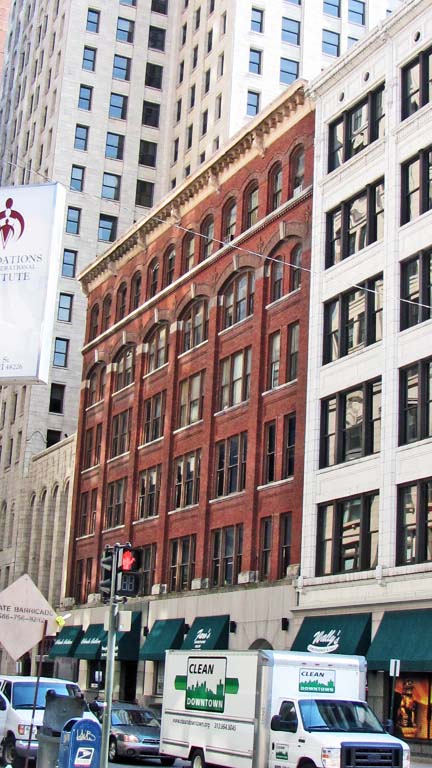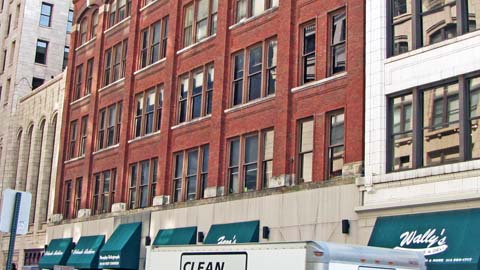

The entrepreneur and investor, Simon Jones Murphy, played a role in the economic development of the state and helped to add four large and attractive structures to what is now the Detroit Financial District Historical area. Born in 1815 in Maine, Mr. Murphy grew up in that state and successfully invested in the timber industry there. Maine’s forests, similar to those in Michigan, were primarily pine. About the time of the Civil War, Murphy realized that much of the valuable timber of the Pine Tree State had been harvested and that his financial prospects might be brighter elsewhere. In 1866, he moved his family from Bangor, Maine to Detroit where he spent the next 49 years of his long life. Presumably, he knew about the white pine forests that covered much of the Lower Peninsula.
Shortly after arrival in Detroit, he established a lumber firm with two partners, Mr. Eddy and Mr. Avery. Between the late 1860s and the 1890s they purchased several hundred thousands of acres of land in the Lower Peninsula so that they might cut the timber. A major challenge they faced was getting the lumber out of the Michigan forests, then to mills and finally to the manufacturing firms that produced products from their wood. For this reason, many of the early investors in Michigan’s prosperous timber industry also were involved in building railroads and organizing Great Lakes steamship lines. At that time, much of Michigan was swampy and there were no paved roads and few railroads. White pine trees were valuable but it was a costly proposition to cut them and then get them to where they would be useful. By the mid to late 1880s, rail lines minimized some of those problems.
Simon Jones Murphy prospered. He realized that Detroit was a booming industrial city because of the many manufacturing firms here that used lumber from the state and iron and steel produced in Detroit. As Detroit's manufacturing industries grew, there was a need for both office structures and buildings for manufacturing.
Manufacturing processes were very different around 1900 from what they are now. Murphy recognized that there were many small manufacturing firms that would rent space in a building designed specifically for their use; a building that included an ample supply of  both electrical and steam power for operating machines. Hence, the strange sounding name, the Murphy Power Building. I believe that this was the first major building in which he invested. It was completed in 1905, shortly after he died at age 90. His son, Charles Murphy, took over the management of his enterprises. Before his death, Murphy invested in the adjoining Penobscot Building on West Congress, an office building completed in 1906. Murphy selected that name either to honor the Penobscot Indians of Maine or the mighty Penobscot Rive in that state, a river that his lumber firm presumably used to get timber to mills. The final two building in the Murphy holdings were the Telegraph Building on Shelby and the Marquette Building further down West Congress at its intersection with Washington Boulevard. The Marquette Building capitalized upon the success of the Murphy Power Building and supplied electrical and steam power to the various manufacturing firms that rented space there.
both electrical and steam power for operating machines. Hence, the strange sounding name, the Murphy Power Building. I believe that this was the first major building in which he invested. It was completed in 1905, shortly after he died at age 90. His son, Charles Murphy, took over the management of his enterprises. Before his death, Murphy invested in the adjoining Penobscot Building on West Congress, an office building completed in 1906. Murphy selected that name either to honor the Penobscot Indians of Maine or the mighty Penobscot Rive in that state, a river that his lumber firm presumably used to get timber to mills. The final two building in the Murphy holdings were the Telegraph Building on Shelby and the Marquette Building further down West Congress at its intersection with Washington Boulevard. The Marquette Building capitalized upon the success of the Murphy Power Building and supplied electrical and steam power to the various manufacturing firms that rented space there.
Simon Murphy and his sons were very active capitalists with diverse holdings. Simon Murphy headquartered his Great Lakes steamship line in Port Huron. He also invested in a major fruit farm in California and built a large home there, a place to which he retreated in winter. He and his son realized that much or most of the valuable timber in Michigan had been cut by the time of the economic Panic of 1892. He son, Simon Murphy Jr., went to Wisconsin where timber was available and established a similar business there. He also served as mayor of Green Bay from 1899 to 1901. Along with colleagues, Simon Murphy established the Pacific Lumber Company in California. For much of the Twentieth Century, this firm was the largest harvester of redwood.
It is very difficult to take an attractive picture of the Murphy Power Building because Detroit’s financial district has the canyon-like environment we associate with lower Manhattan. You cannot get far enough back from the buildings to take an attractive, encompassing picture of the large and tall buildings. This is a six-story, flat roofed building erected with brick and terra cotta. I do not know who designed this building but Murphy commissioned John Donaldson and John Meier to design the first Penobscot Building that was completed one year later. It is reasonable to guess that Donaldson and Meier designed this structure. The first renters were producers of shoes and cigars. Detroit, in 1900, was a major center for the production of cigars, snuff and cut plug tobacco. German immigrants very familiar with the cigar trade realized that tobacco from the sunny plains of southern Ontario along the north shore of Lake Erie would create fine cigars and cut plug. However, by the time the Murphy Building was completed, I think that much of the tobacco processed in Detroit was grown in Cuba. Printers and publishers also used the manufacturing facilities of the Murphy Building. At some point, I presume in the early 1920s, the building was converted to office space and then joined to the Telegraph Building that faces Shelby, not West Congress.
Architect: Unknown to me; Perhaps John Donaldson and John Meier
Date of Completion: 1905
Use in 2011: Office building
Photograph: Ren Farley; September 14, 2011
City of Detroit Designated Historic District: Not listed
State of Michigan Registry of Historic Sites: Not listed
National Register of Historic Places: This building is within the Detroit Financial District. Listed December 24, 2009
Description prepared: September, 2011
Return to Detroit Financial District on National Historical Register
Return to Commercial Buildings
Return to Home Page